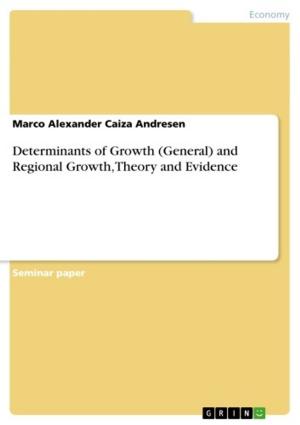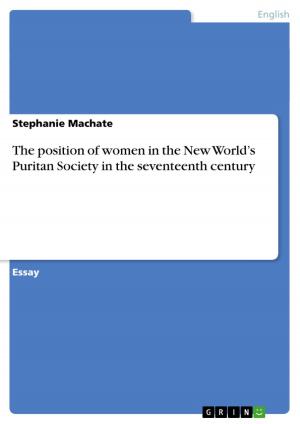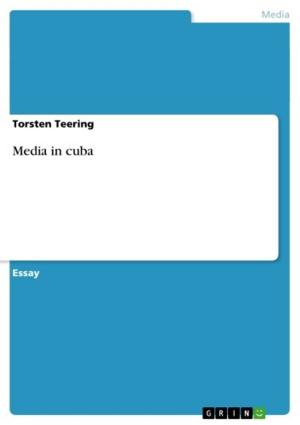Fatherhood and Paternity in Joyce's 'A Portrait of the Artist as a Young Man'
Fiction & Literature, Literary Theory & Criticism, British| Author: | Theresa Schneiderwind | ISBN: | 9783640480838 |
| Publisher: | GRIN Publishing | Publication: | November 26, 2009 |
| Imprint: | GRIN Publishing | Language: | English |
| Author: | Theresa Schneiderwind |
| ISBN: | 9783640480838 |
| Publisher: | GRIN Publishing |
| Publication: | November 26, 2009 |
| Imprint: | GRIN Publishing |
| Language: | English |
Seminar paper from the year 2008 in the subject English - Literature, Works, grade: 1,7, Free University of Berlin (Englische Philologie), course: Surveying English Literatures - Sons & Fathers in Modern Autobiography and Fiction, language: English, abstract: The relationship between father and son is picked out as a central theme throughout literary history. In Modernism this topic is paid special attention due to new philosophical and psychological approaches. Ideas like Freud's psychoanalysis allowed new perspectives on identity that often resulted in a dispute with the previous generation. The conflict between father and son lends itself to portrait this confrontation on a personal level as well as to refer to a wider social context. The concept of patriarchy, the rule of the father, is embedded in every social structure of society: the nuclear family, the Catholic community, the national state. Therefore, contemplation about these bodies metaphorically represents a confrontation with the father. Joyce as one of the major Modernism authors consecrates himself to the topic of father-son-relationships in his autobiographical Künstlerroman A Portrait of the Artist as a Young Man . The author seizes the topic to portrait crucial points in the development of the protagonist, Stephen Dedalus. Moreover, the construction of the potential father figures points to the underlying theoretical concept of fatherhood and paternity. Joyce uses the concept of paternity to display his concept of authorship. A discussion of the terms fatherhood and paternity will serve as the foundation of my analysis. A clear distinction between the two terms is helpful in order to descry potential father figures and to differentiate social interaction (fatherhood) from philosophical debate (paternity). Male adults who take the role of a father to Stephen are his biological father Simon Dedalus and the priests of the Roman Catholic Church. Additionally, other father figures appear: Stephen's namesakes Saint Stephen and Dedalus the Greek artificer. My close examination of the potential father figures will show differences and similarities between them and will give an explanation for either failure (Simon, priests) or success (namesakes) in influencing Stephen's future. In the second section of my essay I will examine Stephen's statement about paternity taken from Joyce's later work Ulysses. My analysis will show that Joyce is not only concerned with the social interaction between father and son. He uses the topic of father-son-relationship to unfold his own theory of paternity and combines it with his ideas about authorship.
Seminar paper from the year 2008 in the subject English - Literature, Works, grade: 1,7, Free University of Berlin (Englische Philologie), course: Surveying English Literatures - Sons & Fathers in Modern Autobiography and Fiction, language: English, abstract: The relationship between father and son is picked out as a central theme throughout literary history. In Modernism this topic is paid special attention due to new philosophical and psychological approaches. Ideas like Freud's psychoanalysis allowed new perspectives on identity that often resulted in a dispute with the previous generation. The conflict between father and son lends itself to portrait this confrontation on a personal level as well as to refer to a wider social context. The concept of patriarchy, the rule of the father, is embedded in every social structure of society: the nuclear family, the Catholic community, the national state. Therefore, contemplation about these bodies metaphorically represents a confrontation with the father. Joyce as one of the major Modernism authors consecrates himself to the topic of father-son-relationships in his autobiographical Künstlerroman A Portrait of the Artist as a Young Man . The author seizes the topic to portrait crucial points in the development of the protagonist, Stephen Dedalus. Moreover, the construction of the potential father figures points to the underlying theoretical concept of fatherhood and paternity. Joyce uses the concept of paternity to display his concept of authorship. A discussion of the terms fatherhood and paternity will serve as the foundation of my analysis. A clear distinction between the two terms is helpful in order to descry potential father figures and to differentiate social interaction (fatherhood) from philosophical debate (paternity). Male adults who take the role of a father to Stephen are his biological father Simon Dedalus and the priests of the Roman Catholic Church. Additionally, other father figures appear: Stephen's namesakes Saint Stephen and Dedalus the Greek artificer. My close examination of the potential father figures will show differences and similarities between them and will give an explanation for either failure (Simon, priests) or success (namesakes) in influencing Stephen's future. In the second section of my essay I will examine Stephen's statement about paternity taken from Joyce's later work Ulysses. My analysis will show that Joyce is not only concerned with the social interaction between father and son. He uses the topic of father-son-relationship to unfold his own theory of paternity and combines it with his ideas about authorship.















